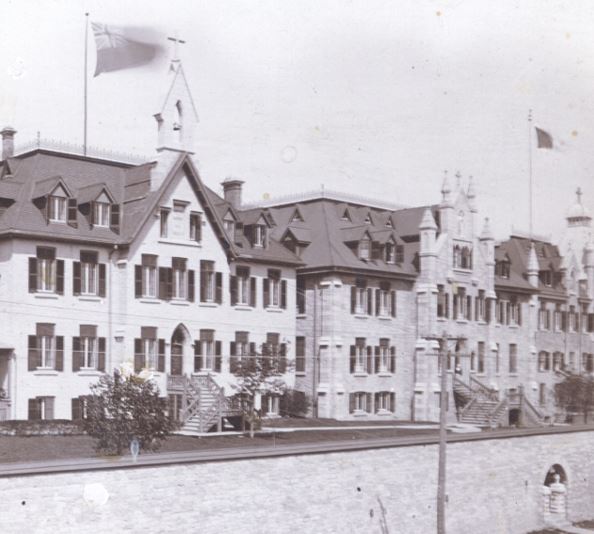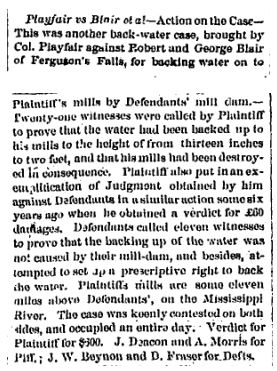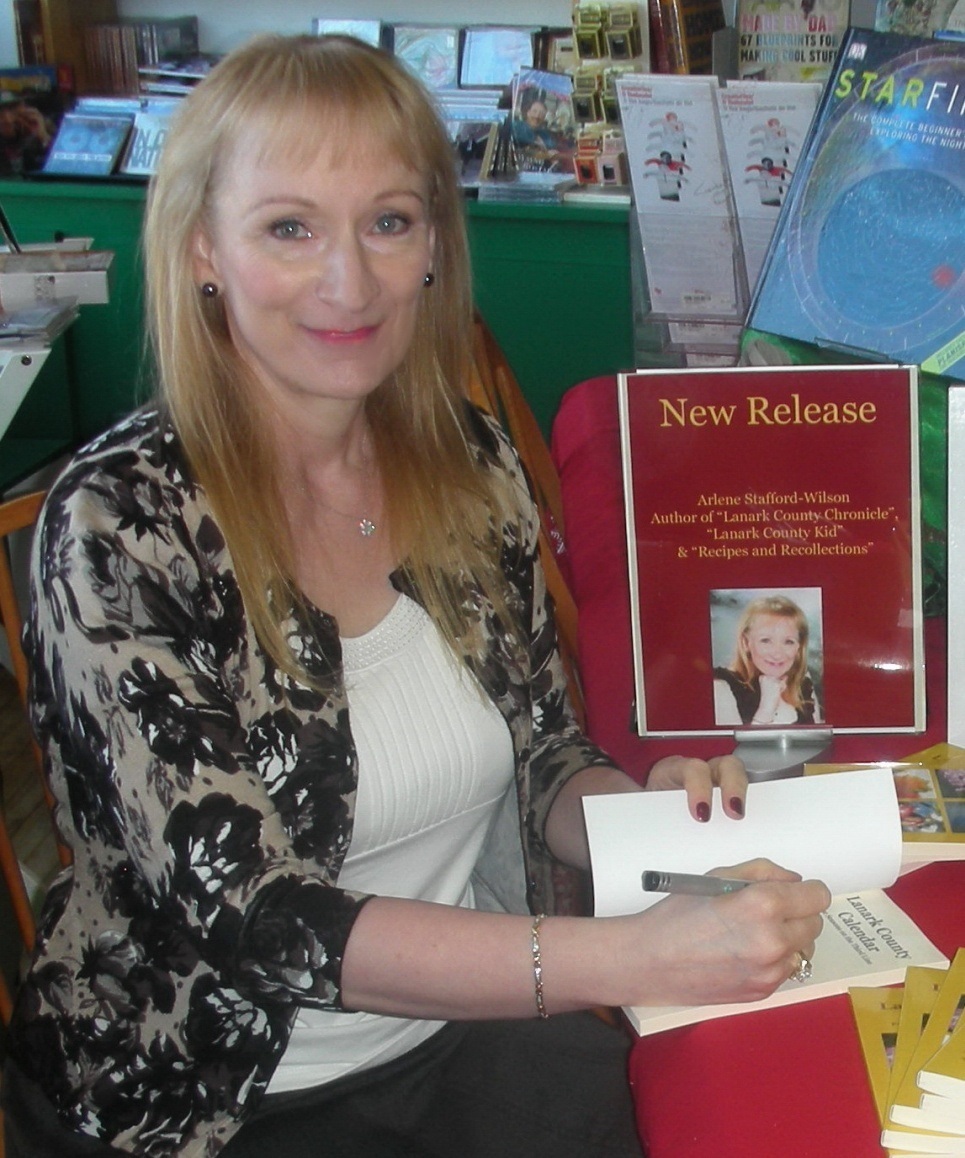Whenever I saw the big white and pink Chaplin’s Dairy truck pull into the yard, I had only one thing on my mind; and that was their delicious chocolate milk. It came in small pint-sized glass bottles, and had a round, waxed cardboard cap on the top to seal it in. The cap had a little tab, so that you could pull it off of the bottle, and the pint bottle was the perfect size for small eager hands. After the cap was off, I was just seconds away from tipping the bottle and tasting the richest, creamiest chocolate milk ever produced.

Our Dad worked for Chaplin’s Dairy for decades. He drove one of the big pink and white trucks, and had a regular ‘route’ of customers in Perth. He used a big, black, metal carrier to transport milk from the back of the truck to the customer’s front door. The carrier had eight slots, and each slot held a quart bottle of milk. He also had a book of order slips. It was a small, thick pad of paper about three by six inches, stapled together at the end. There was a top sheet that was numbered, a small sheet of carbon paper under that, and a blank sheet at the bottom. On the top copy, Dad wrote the customer’s name, address, and what they had ordered, along with the total price and that was the customer’s copy. Because each order was written on top of the sheet of carbon paper, the Dairy had a carbon copy underneath for their records.
Once in a while Dad would bring me to the Dairy and I was fascinated to see the many steps that the milk went through in order to end up on someone’s table. It was fun to sit in the big truck so high up, and the ride was very different from our car at home. The truck bounced up and down a lot more, and made a lot of noise, as we drove down the lane, and up the third line toward Perth. It was neat to look outside, and see how much lower the other cars were on the road. Every time we’d go over a bump or hill the truck would bounce again, and of course there were no seat belts in those days, so it was quite exciting.
We’d drive along until we could see Nick and Doreen Webber’s house at the corner, and we’d begin to slow down. Just a bit past Webber’s house we turned right, and Chaplin’s Dairy was a small building on the right side of the road, just up from the corner at Glen Tay.
We’d park the truck, and I would follow Dad into the Dairy. As soon as he opened the door I could see all of the steam in the air. It was really, really, humid. The inside of the building was grey and concrete and the floor was always wet. Sometimes we’d see one of the Chaplin brothers Cameron or John, and they always wore big rubber boots and the steam rose up all around them.
Because the milk came in glass bottles in those days, a lot of the steam was produced from the big machine that they used to sterilize the bottles. When the customers were finished with their milk, they would rinse their bottles (hopefully!), leave them on their doorstep for Dad, and he would bring them back to the Dairy that evening. John or Cameron Chaplin would take the empty bottles and put them through the bottle washer. The bottle washer washed, rinsed, sterilized, and then rinsed again, so the bottles were sparkling clean and ready for the next batch of milk.
The next machine filled the bottles, then capped them with the little waxed cardboard caps. There was a large room toward the back of the Dairy, and that was a cold storage room, where the freshly bottled milk was kept. Most of the time when I visited I saw them bottling homogenized, 2 per cent, skim, and chocolate milk. Sometimes, one of the Chaplins, would hand me a pint bottle of chocolate milk, right off of the filling machine. I would gladly accept, and thought to myself that if Mother was here she would say that I was going to spoil my supper. Dad never said anything though, because he knew how much I loved Chaplin’s chocolate milk.
Chaplin’s Dairy was a family business. The dairy was started by Delbert Chaplin in the early 1900s, and his brother Edgar Chaplin also worked in the business. The Chaplin family owned a large 300 acre farm at R.R 4 Perth and Delbert demonstrated his ingenuity by setting up a method to process their milk from their Holstein herd. At first he operated the business from their farm, but later in 1935 he built the Dairy building at Glen Tay corners.

1920 – Edgar Chaplin, (Uncle of John and Cameron Chaplin)

Chaplin Dairy Sleigh –Thanks to Gay Lea Dairy Museum, Aylmer, Ontario
When Chaplin’s Dairy began to deliver milk from the new location at Glen Tay, the quarts of milk were just 5 cents each, and it was delivered by horse and wagon. The milk was not bottled at that time but was distributed to the customers from a large tank at the back of the wagon. The customer would leave a container on their front step or front porch, and Delbert or Edgar would ladle the milk out of the larger can with a pint or quart measure.
The Chaplin farm was producing an average of 3,000 quarts of milk per day and John, Cameron and their brother Don processed the milk and delivered it in the Perth area.

photo: Nancy Gingerich
The demand for their milk increased, and they expanded, and made arrangements to have five neighbouring farms supply their business with additional milk. They were also producing chocolate milk and buttermilk at that time. They made butter as well, but only to supply their own families and it wasn’t for sale to the public.

L to R: Gordon Chaplin, (Royce Frith seated in truck), Donald ‘Don’ Chaplin
By 1945 the sons had taken over the dairy farm and Don took on the responsibility of managing the farm, but their father continued to be active at the Dairy. They continued to expand their business and operated for many decades. They expanded their product line to include grape juice and orange juice.They were successful and respected in the community and were known for their high quality products throughout the Perth area.
Memories of Chaplin’s Dairy:
Tim Stafford: ” When I turned nine, Mom told Dad that she could no longer put up with me on Saturdays because of my bad behavior. That’s the ‘how and why’ of me working with Dad, on the milk truck for Chaplin’s Dairy.
I wasn’t much help at first, but he gave me fifty cents and a chocolate bar purchased at McGlade’s service station, on Gore Street.
Later, when I got my driver’s license, John Chaplin hired me and another high school student, Don Lindsay, to do his milk route, and the Christie Lake cottage route, while he covered the other routes and the ‘inside’ workers for summer vacations.
We were making $25.00 a week, plus we were expected to eat at the restaurants we delivered to on a rotating basis. The daily meal was paid for by Chaplin’s Dairy. John Chaplin’s favourite restaurant was Wong’s Chinese, but Don and I preferred ‘The Bright Spot’, where Muz MacLean, Hillis Conroy’s son-in-law worked. We usually ordered grilled cheese, french fries, and cokes.”

Quart milk bottles – 1960s
Roger Stafford: “I am not positive, but I believe I was about 12 when I started working Saturdays and summers with Dad on the milk truck. The first Summer I worked with Dad, our brother, Tim, was working with Grant or Gary Chaplin.
They were delivering to the stores and restaurants in Perth, and to summer camps and cottages. They drove to Christie Lake to deliver to Cavanagh’s (general store) and the Lodges (Norvic Lodge and Arliedale Lodge) . I believe Tim had been Dad’s helper on the milk truck, prior to me starting to work with Dad.
We used to be at the dairy by 7:00 a.m., and usually got home between 17:30 and 18:00 in the evenings. When I first started with Dad, we delivered milk out of the back of a pickup with a tarp over the glass bottles to protect them from the sun and cold. Milk was 23 cents a quart bottle, and 25 cents for chocolate milk. We also had pints and half pints in glass bottles. Whipped cream and buttermilk were also carried on the truck. It was not long after I started that we used an enclosed truck to deliver out of. It was much easier, but it had no air conditioning, and a piss-poor heater. When I worked six days a week in the summer, I earned $6. for the week.”
In 1970 Don decided to sell the farm and a few years later in 1974 John and Cameron made the decision to stop processing the milk themselves and just be distributors. In total, John worked for 42 years in the business and Cameron for 30. At that time Chaplins were one of the last small dairies that still processed their own milk. They began to sell milk for Clark’s Dairies in Ottawa. John felt that there were too many changes taking place at that time and that the cost would be too prohibitive to continue processing their own milk.
The milk industry in the 1970s was changing from glass bottles to paper cartons,although most customers preferred the taste of milk in glass bottles. The process of returning and washing the bottles was becoming too time consuming, and too expensive. The federal government was also insisting that businesses use the metric system. This conversion would have meant purchasing new equipment because their milk was sold in pints and quarts, and they would have to begin selling in litres.
At the point in time when John and Cameron decided to sell the business, they had 1,000 customers, and a modern fleet of trucks, doing 12 runs per day, with four salesmen. They also offered a complete line of dairy products which included cottage cheese, eggs and also several types of juice. Their last delivery was made by Cameron, on Sept. 17, 1977 and their milk at that time, was 65 cents a quart.
Chaplin’s Dairy was sold that year to Bill McConachie. Bill was formerly a driver for many years who brought the milk from Ottawa. His plan was to begin delivering milk to Smiths Falls, to increase his market.
It’s likely difficult for the younger generation to believe that milk was delivered door to door each day, or that it had no expiry date stamped on the bottle. The milk was fresh from the cow either that day, or the day before, processed at Chaplin’s Dairy, and delivered right to your door step. There was no need for an expiry date. It’s also interesting that they managed to have a pretty successful recycling process of sterilizing the bottles and getting them back on the trucks by the next morning. That was all accomplished without ‘blue bins’ and recycling plants.
Did the milk taste better in a glass bottle? Yes, it did; and anyone who has drank it from a bottle will tell you the same thing. We certainly drank enough of the stuff at our house to offer an opinion on that. One of the benefits of having your father work as a milk man is that he brought home enough milk for the family, each night, in his milk carrier. When you are raising five children, that’s a lot of milk. We were fortunate to have had such fresh milk each and every day and we never ran out.

One Pint, glass milk bottle, 1960s
Although the work wasn’t easy, I believe that Dad enjoyed his customers in Perth, and the quick chats had each day. Whenever Mother and Dad shopped at the IGA on Wilson Street, customers from his milk route would often come up to say ‘Hello’, and exchange a few words. Dad was well liked, and at Christmas his customers showered him with gifts. He received many, many boxes of chocolates, packs of cigarettes and one and two dollar bills in lovely Christmas cards. He was always late getting home Christmas Eve, and part of the reason was that his customers took a few extra minutes to wish him a Merry Christmas, and give him their gifts.
We were fortunate to have grown up at a time when there were family businesses, producing high quality products, and selling them door to door. At one time we had a milk man, an egg man- (Mr. Greer), and a bread man, delivering right to our door.
As the years passed by, many of the small family businesses have closed down, one by one, and in many cases our products are produced far away by people we don’t know. There are dates stamped on the products now telling us when they are destined to ‘expire’. We often have no idea what processes are used to make some of the things that we eat, and so we purchase them on faith alone. Gone are the days when we always knew what we were eating, and even knew the people that made the goods.
Now, we are left with the memories of Chaplin’s, our small, local dairy in Glen Tay. It was a place where we could stop by for a visit and be greeted by John, Don, or Cameron in their big rubber boots, clouds of steam rising all around them. With a big smile they’d pluck a pint of chocolate milk off of the line, and hand it to a little girl from down the road. Their products were made with pride and care, and they were confident that their customers would be satisfied. For years, Chaplin’s Dairy was a well known business in our community, and their products were enjoyed in Perth and area homes for many, many decades.

Arlene Stafford-Wilson
Member, Association of Professional Genealogists
Honorary Life Member, Lanark County Genealogical Society
Lanark County Pioneer Families Humanitarian Award
Author of : “Lanark County Christmas”, “Lanark County Comfort”, “Lanark County Collection”, “Lanark County Calling”, “Lanark County Classics”, “Lanark County Connections”, “Lanark County Calendar”, “Lanark County Chronicle”, “Lanark County Kid”, & “Recipes & Recollections”, and “Lanark County Kitchen: A Maple Legacy from Tree to Table”
(excerpts from ‘Lanark County Kid: My Travels up and down the Third Line’)

Memories of working at Chaplin’s Dairy – my brothers Tim Stafford and Roger Stafford, excerpts from the book ‘Recipes and Recollections: Treats and Tales from our Mother’s Kitchen’







































































































































































